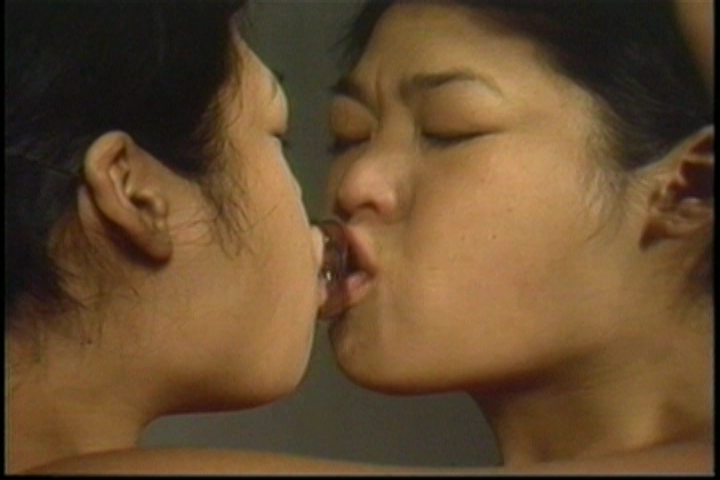
To mark the opening of M+, Hong Kong’s new museum of visual culture, ArtReview is selecting highlights from the museum’s collection as part of its ‘Work of the Week’ series. Patty Chang’s Fountain is the last instalment in a weekly focus on the background story of a single work and the network of associations it conjures
At first glance, Fountain is all about self-love. It opens with a close-up image of the face of its creator, American performance- and video-artist Patty Chang, staring intently at a reflection of herself, as if to test the maxim that the eyes are indeed the mirror to the soul. And during the entire five-and-a-half-minute video the camera never moves from there.
Chang does, however. Initially, the artist’s expression is focused but emotionless. Then gently, she leans into the mirror and parts her lips as if preparing to plant a kiss. As she leans forward, her breath causes a break-up to the order of the image: the surface of the mirror begins to ripple (bringing to mind mirrors from fairytales such as Snow White). As her lips go on to make contact with that surface, it becomes clear that what seemed to be an act of embracing is in fact an act of consuming, as the artist greedily guzzles the clear liquid that, improbably, constitutes the mirror’s surface. To viewers it’s unclear what motivates this action: desire (You’re so cute I want to eat you up!) or a more complex mix of self-healing and self-loathing (I’m going to suck you back in until I’m whole again!), or, straightforwardly, basically, thirst.
The video is the record of a performance that took place on the floor of a restaurant toilet, where the artist covered a mirror with a thin layer of water, crouched over it and proceeded, with increasingly greater intensity (and noisiness), to slurp it up. Which might make the truth of the work rather more animalistic than erotic. Depending on your point of view and where you think the truth lies. What’s clear, however, is that the work (filmed on a camera set on the ground at a 45-degree angle, with the image righted for its eventual presentation) contains illusion at its heart – the illusion of the mirror, the illusion that conceals the circumstances of the action’s filming, and the illusions of whatever motivational rationales we may apply to the work. Moreover, armed with this knowledge, a work that seemed to be about the enchantment of the double, is now also, perhaps more so, about the labour of a task.
Of course, in one sense Fountain is clearly a work about the history of art. It shares its title with Marcel Duchamp’s most famous work, a porcelain urinal displayed lying on its back, produced at least in part, to test the limits of what society might tolerate as art, by proposing that something designed to contain human effluent could be turned into a symbol of human affluence.
And, of course, Chang’s actions relate to the ancient myth of Narcissus, the most famous artistic rendition of which was painted by Caravaggio (in 1594–6) and features his subject, crouched over the still waters of a lake staring at his reflection staring back at himself. (The tale, as set out by Roman poet, Ovid, in Metamorphosis [eighth century, CE], goes that Narcissus, a handsome young man who spurned all romantic approaches, dies after being unable to tear himself away from the beauty of his own reflection in a pool of water.) Visually, representations of Narcissus are meditations on beauty; the moral of Ovid’s tale is about self-harm.
Chang’s work asks what happens when the Asian female form takes centre stage in these tales – and the polar exchanges they represent – that have been, and indeed are, traditionally spun around male icons: tales foundational to the narratives of Western culture, in which these particular identities (Asian and female) are ‘other’, if they are seen at all. The work leaves us to consider what narratives might be spun around that. So perhaps we might now say that the work is a meditation on how we look out at the world and how the world looks back at us. And how we are trained, by myth and legend (among other things), to look at the world and to look at ourselves. How, slurp by slurp, might someone take control of their image rather than leaving that up to someone else?
In this way, as is the way of all good art, something apparently simple becomes complex. And, over time, it has become more complex still: a prime example of how a work of art can acquire new meanings, relevancies and connections to the world as that world evolves. Today we might think of it in relation to the projections of the self in the age of avatars and projected identities in social-media or the wider digital sphere. Alongside questions of the self(s) that we broadcast, the work speaks too to the self that is constantly surveilled. We might think about the kind of embedded social prejudices and violence against Asian bodies that rose up during the Coronavirus pandemic and widely spread racist characterisations (by Donald Trump and many others in the US and Europe) of the virus as ‘Chinese’ or as ‘Kung flu’. Fountain, then, truly is a living work of art.
Patty Chang’s Fountain (1999) can be played on demand in the Mediatheque at M+, Hong Kong